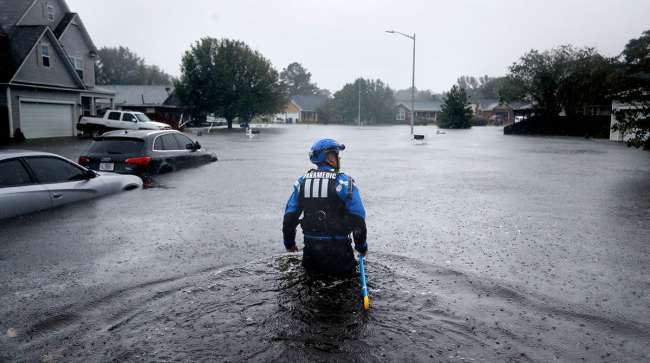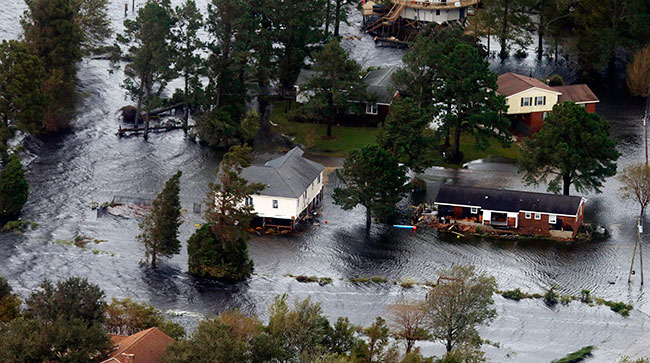Florence Flooding Spreads as Storm Heads Northeast

WILMINGTON, N.C. — With Wilmington cut off from the rest of North Carolina by still-rising floodwaters from Florence, officials plan to airlift food and water to the city of nearly 120,000 people as rescuers elsewhere pull inland residents from homes swamped by swollen rivers.
The deadly storm still was dumping rain and had top winds around 30 mph early Sept. 17, but forecasters said it was expected to gradually pick up forward speed and complete a big turn toward the Northeast.
Flooding worries were increasing in West Virginia and Virginia, where power outages also were rising. About 500,000 homes and businesses were in the dark.
The spreading disaster claimed additional lives Sept. 16, with at least 17 people confirmed dead, and the nation’s top emergency official said other states were in the path this week.
- About 1,100 road closures
- Wilmington INACCESSIBLE by land. DON'T travel, let responders work.
- Sections of I-95/40 flooded. No reopen time until crews assess damage.
- Avoid areas S of US 64/east of I-73/I-74
- https://t.co/Pbux7IDYBi: Use the route dropdown & incidents tab pic.twitter.com/XUFfcIoj25 — NCDOT (@NCDOT) September 17, 2018
“Not only are you going to see more impact across North Carolina … but we’re also anticipating you are about to see a lot of damage going through West Virginia, all the way up to Ohio as the system exits out,” Brock Long of the Federal Emergency Management Agency said Sept. 16 on Fox News.
Authorities near Charlotte were searching for a 1-year-old boy who was swept away by floodwaters when the boy’s mother lost her grip on him after her vehicle was swept off a road.
In Wilmington, the state’s eighth-largest city, residents waited for hours outside stores and restaurants for basic necessities such as water. Police guarded the door of one store, and only 10 people were allowed inside at a time.
County commission Chairman Woody White said officials were planning for food and water to be flown into the coastal city.
“Our roads are flooded,” he said. “There is no access to Wilmington.”
About 70 miles away from the coast, residents near the Lumber River stepped from their homes directly into boats floating in their front yards; river forecasts showed the scene could be repeated in towns as far as 250 miles inland as waters rise for days.
In Anson County, east of Charlotte, a train derailed Sept. 16, but it wasn’t clear whether it was storm-related or if anyone was injured. Several cars of a CSX train left the tracks, WBTV reported.
The derailment led to at least one road closure. Officials have reported flooding caused by Florence in Union County, located between Charlotte and Anson County.
Florence still was massive, despite being downgraded to a tropical depression from a once-fearsome Category 4 hurricane. Radar showed parts of the sprawling storm over six states, with North Carolina and South Carolina in the bull’s-eye.
In North Carolina, fears of what could be the worst flooding in the state’s history led officials to order tens of thousands to evacuate, though it wasn’t clear how many had fled or even could.
President Donald Trump said federal emergency workers, first responders and law enforcement officials were “working really hard.” As the storm “begins to finally recede, they will kick into an even higher gear.”
FEMA, First Responders and Law Enforcement are working really hard on hurricane Florence. As the storm begins to finally recede, they will kick into an even higher gear. Very Professional! — Donald J. Trump (@realDonaldTrump) September 16, 2018
As rivers swelled, state regulators and environmental groups were monitoring the threat from gigantic hog and poultry farms located in low-lying, flood-prone areas.
The industrial-scale farms contain vast pits of animal feces and urine that can pose a significant pollution threat if they are breached or inundated by floodwaters. In past hurricanes, flooding at dozens of farms also left hundreds of thousands of dead hogs, chickens and other decomposing livestock bobbing in floodwaters.
Some stream gauges used to monitor river levels failed when they became submerged, but others showed water levels rising steadily, with forecasts calling for rivers to at or near record levels. The Defense Department said about 13,500 military personnel were assigned to help relief efforts.
Authorities ordered the immediate evacuation of up to 7,500 people living within a mile of a stretch of the Cape Fear River and the Little River, about 100 miles from the North Carolina coast. The evacuation zone included part of the city of Fayetteville, population 200,000.

Flooded homes in New Bern. (Steve Helber/Associated Press)
Near the flooded-out town of New Bern, about 455 people had to be rescued from the swirling flood waters. In the neighboring town of Trenton, downtown streets were turned to creeks full of brown water.
The rain was unrelenting in Cheraw, a town of about 6,000 people in northeastern South Carolina. Streets were flooded, and Police Chief Keith Thomas warned people not to drive, but the local food and gas store had customers.
“As you can tell, they’re not listening to me,” he said.

